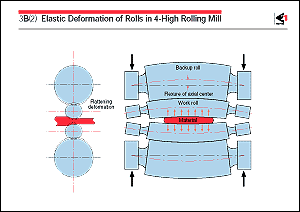All the parts that compose a rolling
mill are subjected to elastic deformation by the rolling force.
The amount of deformation of the rolls by the rolling force
is the largest component of the vertical deformation of the whole
rolling mill, accounting for 60-70% of the total amount of the
deformation. The amount of deformation of the housing and screw-down
device each account for 10-20%.
As shown in the figure, rolls in a 4-high rolling mill are subjected
to four kinds of deformation: (i) deflection of the back-up rolls,
(ii) deflection of the work rolls, (iii) flattening of the work
rolls caused by contact with the back-up rolls and material,
and (iv) flattening of the back-up rolls caused by contact with
the work rolls. The amounts of these four types of deformation
have been analyzed theoretically.
The ratio of the rolling force to the amount of vertical deformation
of the whole rolling mill, including the deformation of the roll,
screw-down device, and housing, is called the mill modulus.
The mill modulus is 500-1,000 ton/mm for plate rolling mills
and 400-600 ton/mm for cold rolling mills. The larger the diameter
of the back-up rolls, the higher the mill modulus. A rolling
force of the order of 1,000 tons is generated during rolling,
so that mill deformation of more than 1mm occurs. Unless this
deformation is taken into account, thickness accuracy cannot
be ensured. Furthermore, because the mill modulus has a finite
value, there exists a minimum thickness below which the rolling
mill cannot reach.
The flattening deformation of the work rolls during rolling requires
corrections to the calculations of the rolling force derived
from deformation theory. The deflection of the work rolls results
in a widthwise distribution of strip thickness in the form of
a convex crown, in which the thickness is greater at the center
of the width and smaller at the edges. This widthwise difference
in thickness is called the strip crown. In addition, a steep
decrease in thickness occurs at both edges of the strip due to
the combined effects of plastic deformation in the width direction,
roll flattening, and roll abrasion. This phenomenon is called
edge drop. Reducing the strip crown and edge drop is the greatest
challenge for materializing accurate profile in strip rolling. |
|
 |
 |
 |
|
|